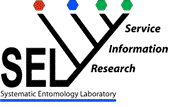Entomology Collections, General
Document Type
Article
Date of this Version
2002
Abstract
Scirtothrips perseae Nakahara was discovered attacking avocados in California,USA, in 1996. Host plant surveys in California indicated that S. perseae has a highly restricted host range with larvae being found only on avocados, while adults were collected from 11 different plant species. As part of a management program for this pest, a ‘‘classical’’ biological control program was initiated and foreign exploration was conducted to delineate the home range of S. perseae, to survey for associated natural enemies and inventory other species of phytophagous thrips on avocados grown in Mexico, Guatemala, Costa Rica, the Dominican Republic, Trinidad, and Brazil. Foreign exploration efforts indicate that S. perseae occurs on avocados grown at high altitudes (>1500 m) from Uruapan in Mexico south to areas around Guatemala City in Guatemala. In Costa Rica, S. perseae is replaced by an undescribed congener as the dominant phytophagous thrips on avocados grown at high altitudes (>1300 m). No species of Scirtothrips were found on avocados in the Dominican Republic, Trinidad, or Brazil. In total, 2136 phytophagous thrips were collected and identified, representing over 47 identified species from at least 19 genera. The significance of these species records is discussed. Of collected material ~4% were potential thrips biological control agents. Natural enemies were dominated by six genera of predatory thrips (Aeolothrips, Aleurodothrips, Franklinothrips, Leptothrips, Scolothrips, and Karnyothrips). One genus each of parasitoid (Ceranisus) and predatory mite (Balaustium) were found. Based on the results of our sampling techniques,prospects for the importation of thrips natural enemies for use in a ‘‘classical’’ biological control program in California against S. perseae are not promising.



Comments
Published in Biological Control 24 (2002) 251–265.